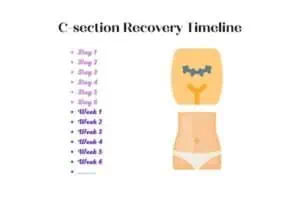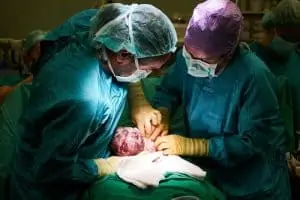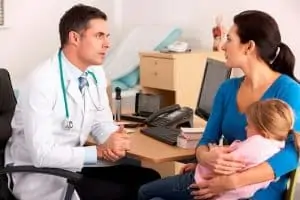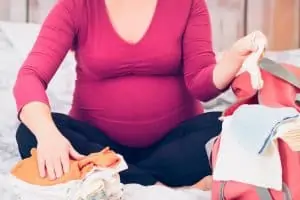I will never forget the pain I felt after my first c-section. I remember clearly thinking I never wanted to do this again (and that soon proved to be a never-say-never thing for me). On the plus side, my husband changed our eldest’s diapers while I was still stuck in the hospital bed.
That first diaper with the meconium in it was all his. But my husband being my husband, had to make a giant ordeal about the whole thing. “Aughhhhh!” he shrieked at discovering the first poop our eldest would ever make. “Oh, my Lord! Oh! P.U.! Oh, what a stink! Gahhhh!” On and on this went, and with his animated gestures and monologue, I couldn’t stop myself from laughing.
Oh, the pain! It was so bad, but I couldn’t stop laughing at him. I laughed so hard and loud that I thought I’d split my incision back open. The doctor checked, assured me everything was sewn up tight, and gave me more pain meds to get some sleep.
The pain after my c-section lasted about a month, improving each day. It was the same after my second c-section too.
But what if, years later, you still feel abdominal pain years after your c-section?
For starters, if you’ve been to your checkups and regular visits with your general practitioner throughout the years, hopefully, you’ve mentioned any abdominal pains. Sometimes, it could be digestive issues or premenstrual cramps.
Lord knows my cramps can throw me off for some months. I’ll think I’ve got a stomachache, and then I’ll feel the tell-tale pangs and know my period is about to show up. My monthly food cravings during my cycle are also my indicator.
If you think your abdominal pain has to do with your c-section, you should schedule an appointment with your gynecologist as soon as possible. You shouldn’t be feeling pain years after your c-section.
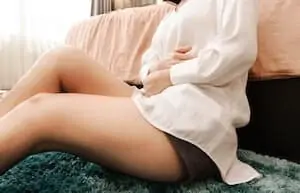
Chronic abdominal pain is much more likely for those of us who have had c-sections (as well as any other surgery in that region, like removing your appendix, for example). It can continuously happen, after eating, while exercising, or when you’ve been sitting or lying down for long periods.
If this sounds like you, you could have abdominal adhesions. These are bands of internal scar tissues that have developed where your incision was. These scars bond deeply inside us, tethering the different layers of our body tissues together where they would otherwise be mobile for normal movement.
Adhesions can affect your muscle movement and digestive processes, not to mention other bodily functions.
How Can You Tell if you have Scar Adhesions?
The only way to know for sure if you have scar adhesions is to get checked out by your doctor. Though the following signs are a pretty good indicator that something isn’t right:
- You have pain at the location of your former c-section incision and the surrounding area
- There’s puckering or dimpling along the scar from your surgery
- You’ve had an MRI or x-ray review, but nothing shows up to explain the pain
According to an article written by Dr. Andrew Beardslee, PT, DPT, MSCS, a study conducted back in the 1990s revealed that 35% of pelvic surgeries or open abdominal surgeries in the U.S. required patients to return more than two times to treat post-surgical adhesions in the ten years following their first surgery.
Yikes, right? Surgery is often the most common treatment to rectify adhesions, but this can create a vicious cycle, which is why some people choose physical therapy instead. We’ll discuss those both in a moment.
Hey, don’t panic, ok? It’s not like it was 95%, plus this was in the 1990s, and things have improved since then. But as good as the surgeon might be, there are risks for developing that scar tissue.
Treatment Options
So now, what do you do if it’s been a full year, 2 years, 3 years, or even more after your last c-section, and you feel abdominal pain at the site of your incision? You’ll have to talk to your doctor to rule out the possibility that it’s anything else. You’ll also have to decide which treatment is best for you.
What are you waiting for if it’s as painful as it was when you first got stitched back up? No one should have to suffer like that! Get that taken care of! Here are some treatment options you can talk through with your doctor.
- Removal surgeries
As mentioned above, you can have surgery to remove the scar tissue. The only downside is that it might temporarily relieve the problem while leaving you prone to developing another adhesion. It’s best to find out all the risks for your particular situation. Also, if it’s been around a year after your c-section and you’re still in pain, you may want to wait just a little longer because sometimes scar tissue issues resolve themselves.
- Adhesion barriers
Haven’t had your c-section yet but are currently panicking from the thought of adhesions? Fear not! This preventative measure might just be the thing for you. These are helpful for c-sections as well as hysterectomies. It might be a good idea to ask your doctor about them.
- Compression treatments
Compression might be another option for you to reduce inflammation and pain. Compression wraps are easy to find at your local supermarket or drugstore if your doctor agrees. It will bring relief from the pain and help minimize the scar tissue.
- Visit a massage therapist
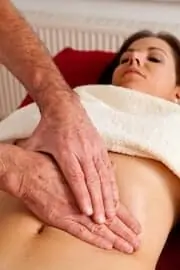
Let’s face it…every mom can do with a massage! But a deep tissue massage or myofascial release can really help with reducing inflammation and working things through.
Make sure you choose a massage therapist with experience with abdominal pain from c-sections. A great way to be sure is to ask your doctor for a reference.
- Physical therapy
Physical therapy may be the right choice if you’re having difficulty with mobility due to abdominal pain at your c-section incision site. It can help get you back to feeling like you again.
- Stretching
Sometimes simply stretching and performing small exercises can make all the difference in the recovery at our point of incision. While this is often prescribed for those with joint pain and injuries, it can also help reduce the pain with internal scar tissues.
Final Thoughts on Abdominal Pain Long After Your C-Section
It’s definitely not normal for you to feel pain in your abdominal area a year or more after your c-section. Ideally, if you still feel as sore as you did right after the drugs wore off post-surgery at your 6-week postpartum checkup, SPEAK UP!
Getting to the root of the problem immediately is much better than letting it fester. But what if you feel fine at your 6-week checkup, and this pain pops up years later? Sometimes, that can happen, though it’s not extremely common.
The bottom line is this…if you notice any of the symptoms I mentioned above, even if they’re happening a good few years after you’ve been stitched back up, get it checked out. You’ll be able to tackle the problem and get back to a pain-free existence, something you deserve!
Leslie Berry lives with her husband and two young daughters in Los Altos, California, where she loves helping other moms get comfortable with motherhood and embracing the insanity with facts peppered with laughs.
She loves eating too much sushi, exercising, and jamming out on her Fender. Read more about Leslie here.



